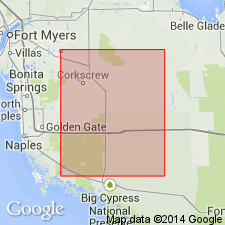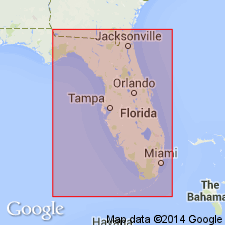
- Usage in publication:
-
- Wood River Formation*
- Modifications:
-
- Named
- Dominant lithology:
-
- Anhydrite
- Dolomite
- Limestone
- AAPG geologic province:
-
- South Florida province
Summary:
Wood River Formation. Is lowermost of four regionally persistent anhydrite units identified below the Punta Gorda Anhydrite in the subsurface of the South Florida basin. Consists of basal coarse clastic rocks overlain by anhydrite and microcrystalline brown dolomite and minor micritic limestone. Thickness is 2,100 feet in type well. Overlies Jurassic (189 Ma) rhyolite porphyry; underlies Bone Island Formation (new). Age is Late Jurassic(?) based on the estimated time interval between rhyolite emplacement and deposition of the basal clastic rocks.
Type section (subsurface): depth-interval 16,510 to 18,610 ft, Bass Collier Company 12-2 well P-778, in sec. 12, T. 52 S., R. 27 E., Collier Co., FL. Named from Wood River, a creek 4 mi southeast of the type well.
Source: Modified from GNU records (USGS DDS-6; Reston GNULEX).

- Usage in publication:
-
- Wood River Formation*
- Modifications:
-
- Age modified
- AAPG geologic province:
-
- Florida platform
Summary:
Age of Wood River Formation is Jurassic(?) and Early Cretaceous, following Faulkner and Applegate (1986).
Source: GNU records (USGS DDS-6; Reston GNULEX).
For more information, please contact Nancy Stamm, Geologic Names Committee Secretary.
Asterisk (*) indicates published by U.S. Geological Survey authors.
"No current usage" (†) implies that a name has been abandoned or has fallen into disuse. Former usage and, if known, replacement name given in parentheses ( ).
Slash (/) indicates name conflicts with nomenclatural guidelines (CSN, 1933; ACSN, 1961, 1970; NACSN, 1983, 2005, 2021). May be explained within brackets ([ ]).

